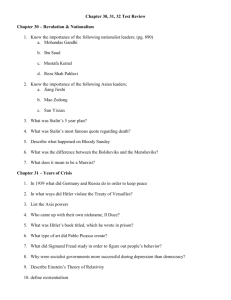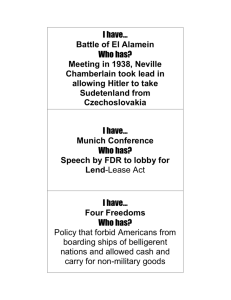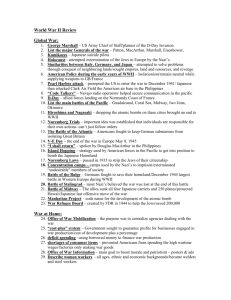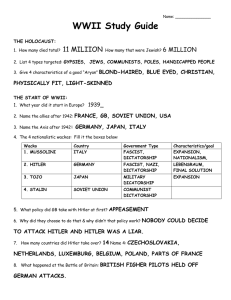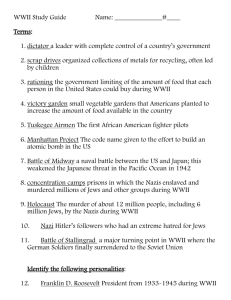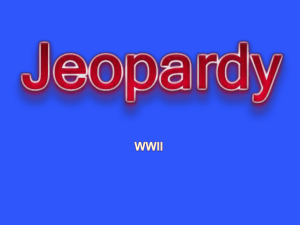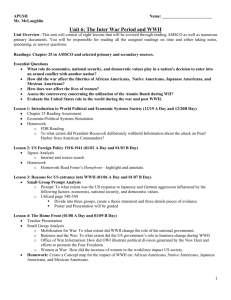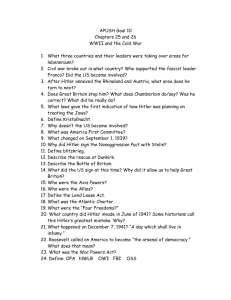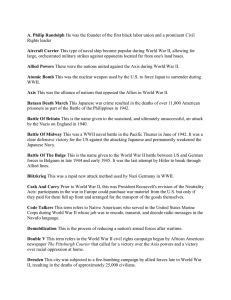World War 2 Timeline Activity
advertisement
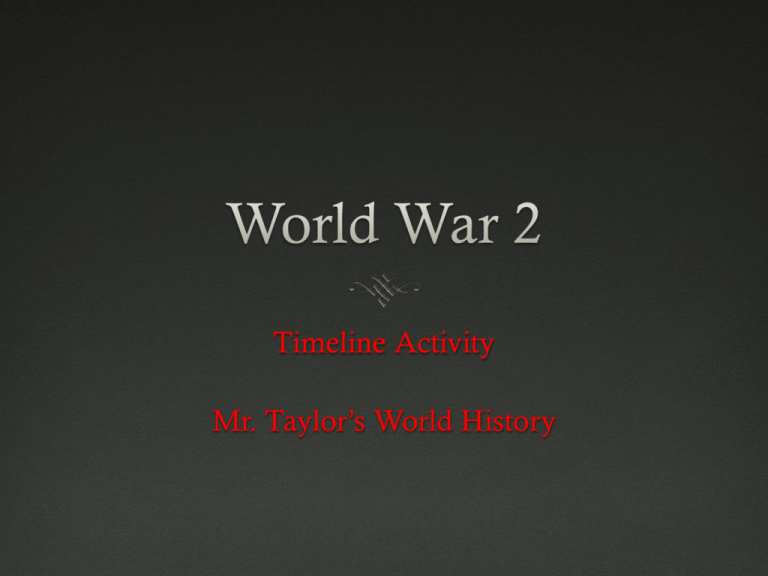
Timeline Activity Mr. Taylor’s World History Directions – Part 1 Working in elbow partners, find the dates of each event description in this presentation. Write the description on the chart provided to you. Identify whether the event described happened in Europe, the Pacific, or on the American Home Front. “Rosie the Riveter” appears on the cover of the Saturday Evening Post magazine as a tribute to women working in defense factories. There will be 3,000,000 Rosies by 1945. Japanese naval and air forces attack the US naval base at Pearl Harbor, Hawaii, plunging the United States into WWII. President Roosevelt signs Executive Order 9066, which soon leads to the internment in isolated camps of more than 110,000 Japanese Americans for the remainder of the war. British Prime Minister Winston Churchill, US President Franklin Roosevelt and Soviet General Secretary Joseph Stalin meet at Yalta, Soviet Union, to discuss post-war reorganization of Europe. American troops driving eastward into Germany meet up with Soviet troops pushing westward toward Berlin at the Elbe River, signaling the near collapse of Hitler’s Germany. Battle of the Bulge: Germany’s last offensive in Western Europe threatens to push the Americans back toward the Atlantic; the largest and bloodiest battle the Americans fought during WWII. The Nuremburg War Crimes Trials of top Nazi political and military leaders begins; many of the horrors of the Holocaust are brought to the public’s attention. US and British forces begin their amphibious invasion of North Africa(Operation Torch) in their first efforts to retake Axis-held territory. In the largest naval battle of WWII, the Japanese navy is defeated at the Battle of Leyte Gulf in the Philippines, where Japanese kamikazes (suicide pilots) are used for the first time. Japan invades Manchuria, a region of northern China that offers the Japanese much needed natural resources. The lack of forceful reaction from the rest of the world emboldens Japan over the next decade. The US Office of Price Administration issues Ration Book Number One to every American to use when purchasing rationed items, including sugar, coffee, and meat. Victory in Europe (V-E Day) is declared as Germany offers unconditional surrender to the Allies. The Women’s Army Auxiliary Corps (WAAC) is created, giving women an opportunity to serve in the Army. It will later be renamed the Women’s Army Corps (WAC). Soviet troops liberate Auschwitz death camp in southern Poland, where the Nazis murdered more than one million Jews since 1940. It was one of six concentration camps built specifically for killing Jews. Following their announcement of surrender two weeks earlier, Japanese dignitaries sign the official surrender documents aboard the USS Missouri battleship in Tokyo Bay, ending WWII. Adolf Hitler, leader of the Nazi Party, becomes chancellor of Germany and almost immediately begins consolidating his power and imprisoning his political enemies. US Marines raise the flag atop Mount Suribachi on Iwo Jima, four days into the 36-day battle for the tiny Japanese-held island. D-Day: in the largest invasion in WWII, Allied forces come ashore in Normandy, France, breaking through Hitler’s Atlantic Wall and starting the long road toward Berlin. American naval forces sink four Japanese aircraft carriers at the decisive Battle of Midway. From this battle, Japan’s vast Pacific empire begins to shrink. The Tuskegee Airmen, African American pilots trained at Tuskegee Airfield in Alabama, undertake their first combat missions protecting bombers flying over Europe. At the urging of President Roosevelt, US Congress passes Lend-Lease Act, which provides Great Britain, the only European power left fighting Nazi Germany, with much needed war supplies. Germany invades Poland; Great Britain and France honor their pledge to support Poland and declare war on Germany; WWII begins. Although not at war, the United States government recognizes the growing danger of the growing war in Europe and passes the first peacetime draft in American history. The United States Army Air Force drops two newly developed atomic bombs, one each on the cities of Hiroshima and Nagasaki, utterly destroying them. Kristallnacht (Night of Broken Glass): a series of coordinated attacks against Jews throughout Germany in which homes, shops and synagogues where burned and 30,000 Jews were arrested and sent to concentration camps. Directions – Part 2 Working in elbow partners, examine the 25 images that follow this slide. Match the image with one of the events from the table. Write the letter of the image on the row it matches on the table. A B C D E F G H I J K L M N O P Q R S T U V W X Y Directions – Part 3 Take your table to Ms. X in order to have it checked.
